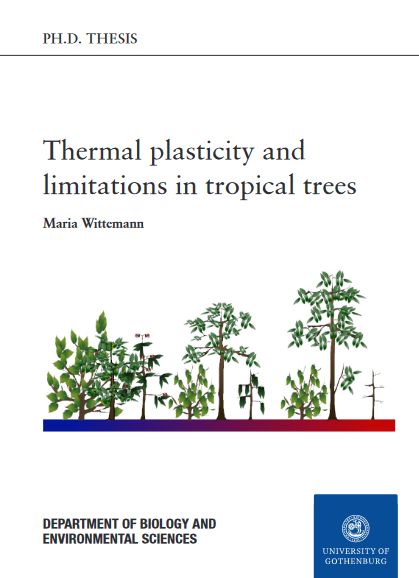Some species of trees are able to handle rising heat in the tropics by sucking up large quantities of water to their leaves and transpiring through wide-opened pores in their leaves. These are mainly fast-growing trees that establish themselves early as a rainforest grows up. The same cannot be said for the trees that make up the canopy of rainforests in old growth forests. They grow slower, but get bigger and taller, and their leaves do not have the same ability to cool themselves via transpiration.
Water powers the ‘air conditioning’
“The tropics have not experienced Ice Ages and have thus had a relatively stable climate historically as well as seasonally. With climate change, it has started to get warmer and then we have seen that some species of trees are showing increased mortality rates, but we have not really known why before,” says Maria Wittemann, who wrote the thesis.
She has studied several species of tree that can be roughly divided into early successional species, which establish themselves early in a new rainforest, and late successional species, which grow slower but grow considerably bigger, and are thus a larger carbon sink over the long term. A clear difference is how the trees in the two groups handle heat. The early successional species open the pores wider in their leaves, through which they transpire large amounts of water, thus keeping down the temperature in their leaves – similar to an air conditioning system. The late successional species do not open their pores as much, and therefore it’s more difficult for them to stay cool.
More sensitive to drought
“We found large temperature differences in the leaves in our measurements. There could be a difference of 10 degrees Celsius between late successional species and early successional species growing in the same location. The late successional species had more difficulty coping with abnormally high temperatures. These trees had a higher mortality rate,” says Maria Wittemann.
However, the early successional species’ profuse transpiration through their leaves also requires a lot of water. During a period of drought, the researchers noted that early successional species became more vulnerable to the heat and dropped their leaves. Their reduced consumption of water meant that late successional species were more resistant to drought.
“Our results show that photosynthesis rates in rainforest trees falls when the temperature rises in their leaves, which occurs mainly in late successional species. The proteins and membranes in their leaves, that are essential for photosynthesis, fail, and eventually the trees die due to carbon starvation because they cannot convert enough carbon dioxide from the air. This affects the entire ecosystem. We know, for example, that some animals eat the fruits of the late successional species,” says Maria Wittemann.
Co-operation with a local university
Previous research shows that the situation is worst in the Amazon. It is estimated that this carbon sink will be transformed into a carbon source by as early as 2035. In African rainforests, climate change has not gone as far.
Research at the University of Gothenburg is being conducted in high-elevation forests in Rwanda in collaboration with the University of Rwanda. The trees have been studied in situ, but seeds have also been planted in climate chambers in Gothenburg to study their development at different temperatures.
“We are working with various stakeholders in Rwanda. There is not much rainforest left in Rwanda and when they plant new trees, they want to know which indigenous species will be able to survive in a warmer climate,” says Maria Wittemann.
in EcoDebate, ISSN 2446-9394
A manutenção da revista eletrônica EcoDebate é possível graças ao apoio técnico e hospedagem da Porto Fácil.
[CC BY-NC-SA 3.0][ O conteúdo da EcoDebate pode ser copiado, reproduzido e/ou distribuído, desde que seja dado crédito ao autor, à EcoDebate com link e, se for o caso, à fonte primária da informação ]
